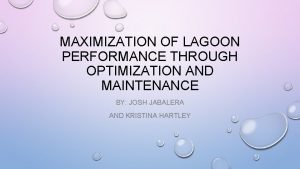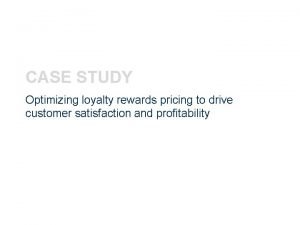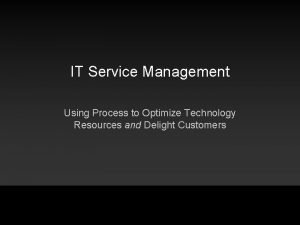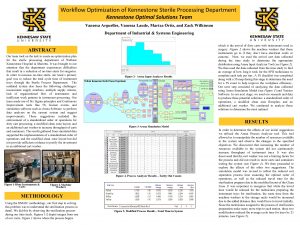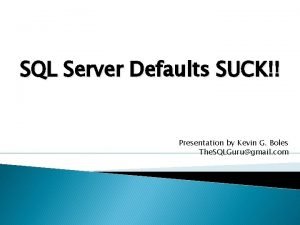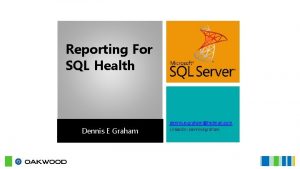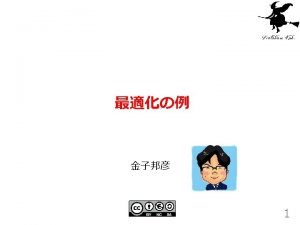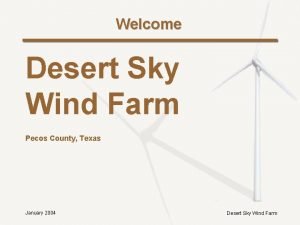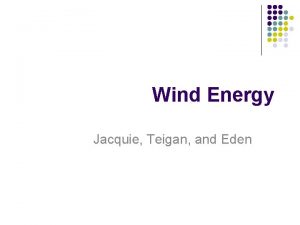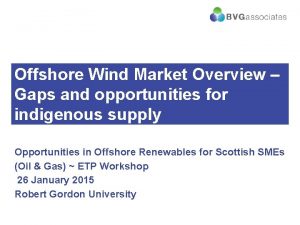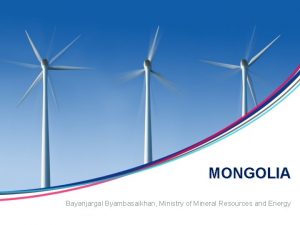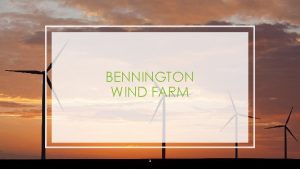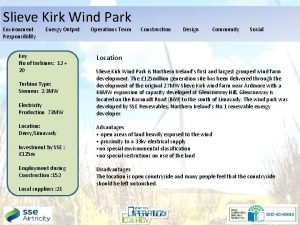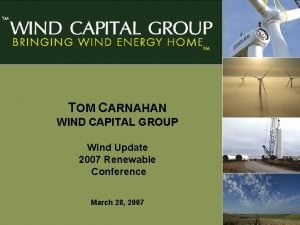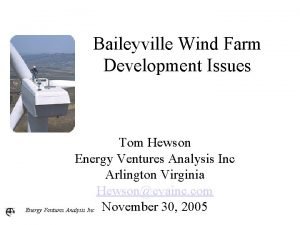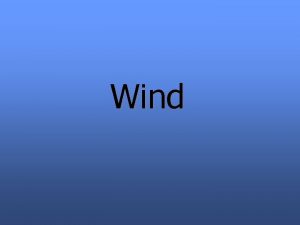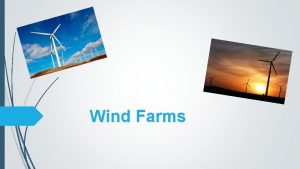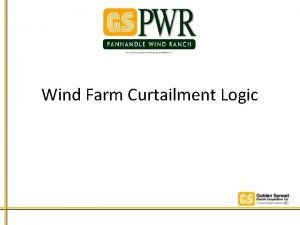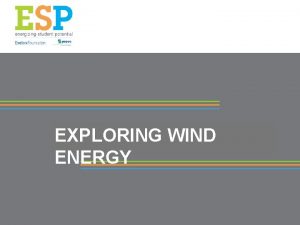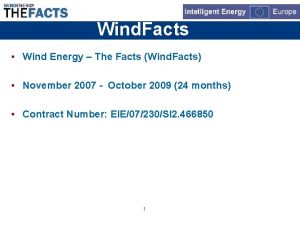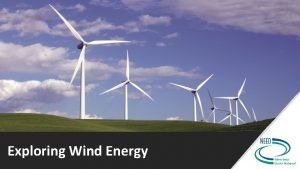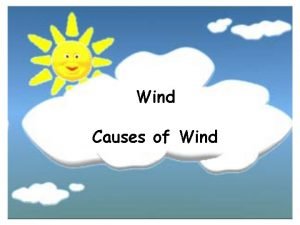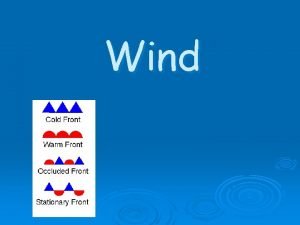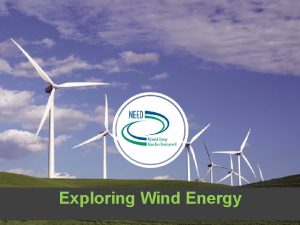Using Maintenance Options to Optimize Wind Farm OM



















- Slides: 19

Using Maintenance Options to Optimize Wind Farm O&M Xin Lei, Peter Sandborn, Navid Goudarzi, Roozbeh Bakhashi, Amir Kashani-Pour Center for Advanced Life Cycle Engineering (CALCE) Mechanical Engineering Department University of Maryland NAWEA 2015 June 11, 2015 Center for Advanced Life Cycle Engineering University of Maryland

Introduction • Operation and Maintenance (O&M) is a large contributor to the life-cycle cost of wind farms, therefore the prediction and optimization of maintenance activities provides a significant opportunity for life-cycle cost reduction. • Maintenance practices for turbines include: - Scheduled preventive maintenance - Corrective maintenance - Predictive maintenance based on prognostics and health management (PHM) or condition monitoring (CM) • This paper applies the concept of predictive maintenance options to both single wind turbines and wind farms managed via power purchase agreements (PPAs) to determine the optimum maintenance dates Center for Advanced Life Cycle Engineering 2 University of Maryland

Prognostics and Health Management (PHM) • Establish failure warnings and a remaining useful life (RUL) • Use the RUL estimate to drive actions to manage systems in such a way as to minimize the life-cycle cost of the system • Maintenance options address how you get “value” from the RUL Individual turbine Wind farm Center for Advanced Life Cycle Engineering 3 University of Maryland

Maintenance Options Predictive Maintenance Opportunity Predicted Remaining Useful Life (RUL) Options: • Maintain at earliest opportunity • Wait until closer to the end of the RUL to maintain • Run to failure for corrective maintenance Options: • Switch to a redundant subsystem (if any) • Slow down • Shut down • Do nothing If I could determine the value of each of the options, I would have a basis upon which to make a decision about what action to take in response to the RUL prediction Center for Advanced Life Cycle Engineering 4 University of Maryland

A Real Options View of Predictive Maintenance • Real Options: The flexibility to alter the course of action in a real assets decision, depending on future developments. - The buyer of the (call) option gains the right, but not the obligation, to engage in the transaction at the future date • Predictive maintenance opportunities triggered by RUL predictions can be treated as Real Options - Buying the option = paying to add PHM into wind turbine subsystems Exercising the option = performing predictive maintenance prior to failure Exercise price = predictive maintenance cost Value returned by exercising the option = revenue lost (negative) + cost avoidance (positive) due to predictive maintenance - Letting the option expire = do noting and run the turbine to failure then perform corrective maintenance Center for Advanced Life Cycle Engineering 5 University of Maryland

Predictive Maintenance Value Simulation for a Single Turbine • Revenue Lost due to predictive maintenance - Representing the value of the part of the RUL thrown away • Cost avoidance due to predictive maintenance including: - Avoided corrective maintenance cost (parts, service, labor, etc. ) Avoided revenue lost during downtime for corrective maintenance Avoided under-delivery penalty due to corrective maintenance (if any) Avoided collateral damage Day 0 Time Day 0 End of RUL Center for Advanced Life Cycle Engineering 6 Predictive maintenance value Time Cost avoidance by predictive maintenance Revenue lost due to predictive maintenance • Predictive Maintenance Value = Cost Avoidance + Revenue Lost Benefit obtained from predictive maintenance at optimum point in time Time Day 0 End of RUL University of Maryland

Path Generation Path = starting at the RUL indication (Day 0), it is one possible way that the future could occur • The revenue path represents the possible revenue due to uncertain wind resources • The cost avoidance path represents how the RUL is used up and varies due to uncertainties in the predicted RUL • Each path is a single member of a population of paths representing a statistically significant set of possible future turbine states Center for Advanced Life Cycle Engineering 7 University of Maryland

Wind Speed and TTF Simulation • Wind turbine: Vestas V 112 -3. 0 MW Offshore • Wind speed simulation - 2003 to 2012 wind data of NOAA Buoy 44009 (in the Maryland Offshore Wind lease area) fitted with Weibull Distribution - Monte Carlo simulation used to get buoy height wind speed paths - Power Law used to transfer buoy height wind speed to hub height • Time to Failure (TTF) - Wind speed → rotor rotational speed → RUL consumption rate → TTF - Represents how the RUL is used up for the subsystem with the RUL prediction (assuming turbine fails thereafter) - Uncertainties in the predicated RUL (in cycles) and wind considered Location of NOAA Buoy 44009 Hub height simulated wind speed Weibull fitted wind speed PDF (UMCP/AOSC: Zeng, Martin; MDA Inc. : Kirk-Davidoff) Center for Advanced Life Cycle Engineering 8 University of Maryland

Predictive Maintenance Value Simulation for a Single Turbine (continued) • Considering the uncertainties in the RUL predictions and future wind speeds: Path terminate at different times due to RUL uncertainties Paths change slope because annual energy delivery target (from PPA) has been reached) Revenue lost paths Center for Advanced Life Cycle Engineering Cost avoidance paths 9 Predictive maintenance value paths University of Maryland

Predictive Maintenance Option Valuation for a Single Turbine (continued) • Predictive maintenance can only be performed on specific dates • On each date, the decision-maker has flexibility to determine whether to implement the predictive maintenance (exercise the option) or not (let the option expire) • This makes the option a sequence of “European” style options that can only be exercised at specific points in time in the future • Real Option Analysis (ROA) is performed for the option valuation: Predictive maintenance option value Predictive maintenance value - Predictive maintenance option value = max[(predictive maintenance value - predictive maintenance cost) , 0] Predictive maintenance cost Day 0 Time Predictive maintenance opportunities Center for Advanced Life Cycle Engineering 10 Day 0 Time University of Maryland

Predictive Maintenance Optimization for a Single Turbine (continued) • On each predictive maintenance opportunity date, ROA is implemented on all paths and the results are averaged to get the expected predictive maintenance option value • This process is repeated for all maintenance opportunity dates to determine the optimum maintenance date Predictive maintenance possible every day Optimum maintenance date: Day 5 Predictive maintenance possible every 2 days Optimum maintenance date: Day 4 Center for Advanced Life Cycle Engineering 11 Predictive maintenance possible every 3 days Optimum maintenance date: Day 3 University of Maryland

Extension to Wind Farms • A wind farm may consist of hundreds of individual wind turbines • Wind farms are typically managed via outcome-based contracts (e. g. , a Power Purchase Agreements) • Maintenance will be performed on multiple turbines (and multiple turbine subsystems) on each maintenance visit to the farm because, - Expensive resources are required (e. g. , cranes, helicopters, vessels) - Maintenance windows are limited due to the harsh environments • Therefore, we must be able to determine the best maintenance date for multiple activities by accumulating the option values Center for Advanced Life Cycle Engineering 12 University of Maryland

Power Purchase Agreement (PPA) A long term outcome-based contract between the wind energy seller and the energy buyer PPA modeling: • Contract energy price - Wind farm annual energy delivery target agreed to by the seller and buyer - Contract energy price applies for each MWh before the target is met • Over-delivery energy price - Over-delivery energy price applies for each MWh exceeding the target - Over-delivery energy price lower than the contract energy price • Under-delivery penalty - Buyer buys energy from other sources (e. g. , burning coal/oil) with replacement energy price for each MWh under-delivered - Seller compensates buyer for each MWh under-delivered with a compensation energy price (equals to the difference between the replacement energy price and the contract energy price) Center for Advanced Life Cycle Engineering 13 University of Maryland

PPA Example • Seller: PPM Energy, Inc. (now Iberdrola Renewables) • Purchaser: City of Anaheim, CA • 20 -year agreement signed in 2003 • Contract energy price: $53. 50/MWh of delivered energy • Constant energy delivery requirement in each hour • From the contract: 3. 1. 2 Sources of Electric Energy and Environmental Attributes - “Seller may obtain electric energy for delivery at the Delivery Point from market purchases or from any other source or sources or combination thereof as determined by Seller in its sole discretion” Nothing in the contract says “only when the wind blows” or “only if the turbines are running” Center for Advanced Life Cycle Engineering 14 University of Maryland

Wind Farm Example • Assume a 5 -turbine-farm managed via a PPA, Turbines 1 & 2 indicate RULs on Day 0, Turbines 3, 4 & 5 operate normally • Predictive maintenance value paths of all turbines with RULs need to be combined together - Because maintenance will be performed on multiple turbines on each visit • The PPA will influence the combined predictive maintenance value paths - Revenue Lost due to predictive maintenance is influenced by: • • Contract energy price Over-delivery energy price Wind farm annual energy delivery target Wind farm cumulative energy delivery from the beginning of the year to Day 0 - Cost Avoidance due to predictive maintenance is influenced by: • • • Contract energy price Over-delivery energy price Compensation energy price Wind farm annual energy delivery target Wind farm cumulative energy delivery from the beginning of the year to Day 0 Center for Advanced Life Cycle Engineering 15 University of Maryland

Predictive Maintenance Value Simulation for a Wind Farm • Considering the uncertainties in RUL predictions and future wind speeds: Revenue lost paths Center for Advanced Life Cycle Engineering Cost avoidance paths 16 Predictive maintenance value paths University of Maryland

Predictive Maintenance Value Simulation for a Wind Farm (continued) • Optimum maintenance plan for the turbines with RULs in a farm subject to a PPA may not be the same as individual turbines managed in isolation Turbine 1 managed in isolation 5 -turbine-farm, Turbines 1 & 2 have RULs, the other 3 turbines work normally Predictive maintenance possible every 2 days Optimum maintenance date: Day 4 Turbine 2 managed in isolation Predictive maintenance possible every 2 days Optimum maintenance date: Day 4 Center for Advanced Life Cycle Engineering 17 Predictive maintenance possible every 2 days University of Maryland Optimum maintenance date: Day 2

Predictive Maintenance Value Simulation for a Wind Farm (continued) • When the number of turbines down changes, optimum predictive maintenance date may also change: 5 -turbine-farm, Turbines 1 & 2 have RULs, 0 turbines down Predictive maintenance possible every 2 days Optimum maintenance date: Day 4 1 turbine down Predictive maintenance possible every 2 days Optimum maintenance date: Day 4 Center for Advanced Life Cycle Engineering 18 2 turbines down Predictive maintenance possible every 2 days Optimum maintenance date: Day 2 University of Maryland

Summary • The work in this paper enables optimum maintenance scheduling for wind farms with PHM that are subject to a PPAs that may include variable prices and penalties • Optimum maintenance scheduling = maintenance dates and actions that minimize the life-cycle cost and maximize the revenue generated for the wind farm • Uncertainties in wind and the accuracy of the RULs forecasted by the PHM approach are included • The optimum maintenance plan for the turbines with RULs in a farm subject to a PPA may not be the same as individual turbines managed in isolation Center for Advanced Life Cycle Engineering 19 University of Maryland
 Optimize wastewater lagoon
Optimize wastewater lagoon Optimize reward program
Optimize reward program It service management
It service management Optimize sterile supply workflow
Optimize sterile supply workflow Ola hallengren index optimize does not work
Ola hallengren index optimize does not work Ola hallengren index optimize does not work
Ola hallengren index optimize does not work Import numpy as np
Import numpy as np Innovia consulting
Innovia consulting Optimise plant availability
Optimise plant availability Wind von backbord weicht wind von steuerbord
Wind von backbord weicht wind von steuerbord Desert sky wind farm
Desert sky wind farm Eden wind farm
Eden wind farm Biggest offshore wind farm produces
Biggest offshore wind farm produces Sainshand wind farm
Sainshand wind farm World biggest wind farm produces
World biggest wind farm produces Bennington wind farm
Bennington wind farm Waymart wind farm
Waymart wind farm Slieve kirk
Slieve kirk Tom carnahan
Tom carnahan Mendota hills wind farm
Mendota hills wind farm
